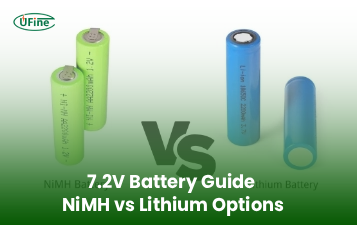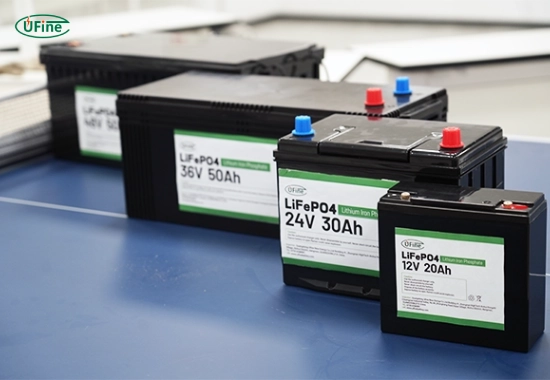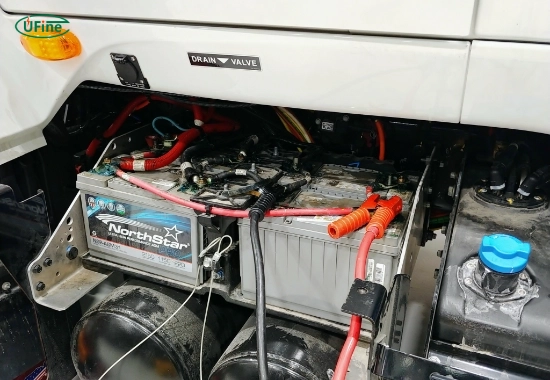
- Part 1. What is a diesel battery?
- Part 2. How does a diesel battery work?
- Part 3. Types of diesel batteries and materials used
- Part 4. Why do diesel trucks need more power?
- Part 5. Why do diesels have two batteries?
- Part 6. What is a battery charger for a diesel truck?
- Part 7. How to jumpstart a diesel truck with 2 batteries?
- Part 8. Which diesel batteries last the longest?
- Part 9. How to maintain diesel batteries for long life?
- Part 10. Common problems with diesel batteries
- Part 11. How to choose the right diesel battery for your truck?
- Part 12. Environmental and safety concerns with diesel batteries
- Part 13. FAQs about diesel batteries
Diesel batteries are essential for powering diesel engines, especially in heavy-duty vehicles like trucks, RVs, and industrial machinery. These batteries supply the energy needed to start diesel engines, which require more power than gasoline engines due to their higher compression ratios.
So, what exactly are diesel batteries, how do they work, what types exist, and why are they so important? This guide will answer all your questions in a clear and human-friendly way.
Part 1. What is a diesel battery?
A diesel battery is a high-capacity rechargeable battery specifically designed to power diesel engines. These engines are commonly found in:
- Pickup trucks
- Semi-trailers
- RVs and motorhomes
- Agricultural and construction machinery
- Marine vessels and generators
Diesel batteries are larger and more powerful than regular car batteries because diesel engines require more cranking power to start. In cold temperatures or high-demand situations, the role of these batteries becomes even more critical.
Part 2. How does a diesel battery work?
When you turn the ignition key in a diesel vehicle, the battery sends a burst of electrical current to the starter motor. This turns the engine over and begins the combustion process. Since diesel engines rely on compression rather than spark plugs, they need more energy to crank.
Once the engine runs, the alternator recharges the battery and powers the vehicle’s electrical systems. Without a functioning battery, a diesel engine won’t start, no matter how good the engine itself is.
Part 3. Types of diesel batteries and materials used
Diesel batteries come in several types, each with distinct materials and advantages. Let’s break them down:
- Flooded Lead-Acid Batteries (FLA)
- Material: Lead plates submerged in sulfuric acid
- Pros: Affordable, reliable, and widely available
- Cons: Requires regular maintenance (adding water), not ideal for deep cycles
- Absorbed Glass Mat (AGM) Batteries
- Material: Lead plates with an absorbed electrolyte in fibreglass mats
- Pros: Spill-proof, maintenance-free, handles vibration well, fast charging
- Cons: More expensive than FLA
- Gel Cell Batteries
- Material: Silica-based gel electrolyte
- Pros: Very stable, great for deep-cycle use, resists vibration
- Cons: Sensitive to overcharging, slower to charge
- Lithium Iron Phosphate Batteries (LiFePO4)
- Material: Lithium compounds, no lead or acid
- Pros: Lightweight, long life (up to 10 years), fast charging, deep cycling
- Cons: High upfront cost, may require a special charger
Each type is suited for different applications. For example, AGM is great for daily use in diesel trucks, while LiFePO4 is ideal for RVs and off-grid systems due to its long lifespan and deep cycling ability.
Part 4. Why do diesel trucks need more power?
Diesel engines are robust, efficient, and more complex to start, especially in cold weather. Here’s why they need more power:
- Higher compression ratios: Diesel engines compress air much faster than gasoline engines.
- No spark plugs: They rely entirely on compression to ignite fuel, requiring more energy for ignition.
- Larger engine components: Heavier pistons and crankshafts take more power to move.
- Cold-start challenges: Diesel fuel thickens in cold weather, increasing resistance.
Because of this, diesel batteries must deliver high Cold Cranking Amps (CCA) to ensure a reliable start every time.
Part 5. Why do diesels have two batteries?
Most diesel trucks have two batteries to provide the extra power needed to start large diesel engines and support onboard electronics. Here’s a breakdown of the benefits:
- Cold weather starting: Two batteries ensure enough cranking power even in sub-zero temperatures.
- Redundant power: If one battery fails, the other can sometimes provide enough juice to start the engine.
- Power for accessories: Modern trucks have GPS, infotainment systems, sensors, and other tech that draw power.
- Load balancing: Two batteries share the load, reducing strain and increasing lifespan.
This dual-battery system is especially common in pickup trucks like the Ford Super Duty, GMC Sierra HD, and Ram 2500/3500.
Part 6. What is a battery charger for a diesel truck?
A battery charger for a diesel truck is a high-output device designed to recharge large-capacity batteries or maintain a charge for dual-battery setups. Here’s what makes them special:
- High amp ratings: Can handle big diesel batteries and charge faster
- Dual-bank charging: Charges two batteries simultaneously
- Smart features: Prevent overcharging, adjust for temperature, manage trickle charging
- Compatibility: Can charge AGM, flooded, gel, and even lithium batteries
Top brands include NOCO, CTEK, Schumacher, and DieHard.
Part 7. How to jumpstart a diesel truck with 2 batteries?
Jumpstarting a diesel truck with two batteries isn’t hard, but you must do it properly:
- Turn off all accessories (radio, lights, etc.)
- Connect jumper cables:
- Red clamp to positive (+) on dead battery #1
- Red clamp to positive (+) on donor battery
- Black clamp to negative (−) on donor battery
- Black clamp to the engine block or chassis of the dead truck
- Start the donor vehicle and let it run for a few minutes.
- Start the diesel truck
- Let it run for 15–30 minutes to recharge both batteries
Warning: Never connect both negative clamps to the dead batteries. Use a ground point to prevent sparks.
Part 8. Which diesel batteries last the longest?
The longest-lasting diesel batteries are usually AGM (Absorbed Glass Mat) or Lithium Iron Phosphate (LiFePO4) types. Here are the top performers:
- Optima YellowTop (AGM): Great for deep-cycle and starting power
- Odyssey Extreme: High performance and long lifespan
- Battle Born Batteries (LiFePO4): Ideal for RVs and off-grid diesel trucks
These batteries can last 5 to 10 years with proper care, while flooded lead-acid batteries typically last 3–4 years.
Part 9. How to maintain diesel batteries for long life?
Proper maintenance ensures consistent performance and extends battery lifespan. Here are essential practices:
- Inspect terminals: Clean corrosion and ensure tight connections
- Check voltage: Use a multimeter—healthy batteries should show 12.6–12.8V
- Monitor fluid levels: Top off distilled water in flooded batteries if needed
- Use a maintainer: Especially for trucks that sit idle for long periods
- Load testing: Done every 6–12 months to check performance under stress
Pro tip: Always replace both batteries simultaneously in dual setups to avoid imbalance.
Part 10. Common problems with diesel batteries
Diesel batteries are tough, but they’re not immune to issues. Watch for:
- Sulfation: Sulfur crystals form on plates, reducing the capacity
- Parasitic drain: Electronics drawing power when the truck is off
- Loose or corroded terminals: Interrupt current flow or prevent starting
- Overcharging: Can lead to gassing, swelling, or leaks
- Extreme temperatures: Heat damages internal plates; cold reduces CCA
Address these problems early to avoid expensive repairs or getting stranded.
Part 11. How to choose the right diesel battery for your truck?
Choosing the right diesel battery depends on several factors:
- CCA rating: Match or exceed the manufacturer’s specs
- Reserve capacity (RC): Important for powering accessories
- Battery type: AGM for durability, Lithium for longevity, Flooded for budget
- Size and fitment: Check the group size to ensure it fits your truck
- Brand reputation: Optima, Odyssey, Interstate, and Battle Born are trusted names
Bonus tip: Always check if the battery is compatible with your charger or maintainer.
Part 12. Environmental and safety concerns with diesel batteries
Diesel batteries contain lead, acid, or lithium, which can be hazardous if improperly handled. Here’s what to keep in mind:
- Recycling: Always recycle old batteries through certified centres
- Ventilation: Flooded batteries release hydrogen gas—keep them in ventilated areas
- Wear protection: Use gloves and goggles when handling acid-based batteries
- Disposal laws: Don’t dump batteries in the trash—it’s illegal in many places
Battery innovations like sealed AGM and lithium reduce risks and are more eco-friendly.
Part 13. FAQs about diesel batteries
What size battery do I need for my diesel truck?
Battery size depends on your truck’s engine displacement and power needs. Check your owner’s manual for the correct group size, CCA rating, and terminal configuration. Most full-size diesel pickups use Group 65 or 31 batteries with over 800 CCA.
Can I mix different battery types in a diesel truck?
No. Mixing AGM with flooded or gel batteries can cause imbalance, uneven charging, and damage. Always use two identical batteries in a dual setup—same type, age, brand, and specs.
How does temperature affect diesel batteries?
Cold weather reduces battery efficiency, lowering CCA and making it harder to start your truck. Hot weather accelerates internal corrosion and evaporation, shortening battery lifespan. In extreme climates, use insulated covers and battery warmers.
Should I disconnect my diesel batteries when storing the truck?
If the truck will sit unused for a month or more, it’s wise to disconnect the batteries or use a smart battery maintainer. This prevents parasitic drain and keeps the batteries healthy.
What voltage should two diesel batteries show when fully charged?
In a 12V dual setup (parallel), both batteries should show 12.6V to 12.8V each when fully charged. In a 24V system (series), you should see 25.2V to 25.6V total. If the readings are uneven, one battery may be failing.
Related Tags:
More Articles

NiMH vs Lithium 7.2V Battery and Charger: Which Is Better?
Compare 7.2V NiMH vs Lithium batteries and chargers in 2025. Learn runtime, weight, charging, lifespan, and cost to choose the best for your device.
How to Choose the Right 7.2V Battery and Charger for Your Device?
Learn how to choose the right 7.2V battery and charger for optimal performance, safety, and longevity across RC, tools, medical, and industrial devices.
Big Square Battery Safety Standards You Must Know
Learn key safety standards for big square batteries to avoid fire risks, shipping delays, and compliance issues in EV, industrial, and energy storage projects.
Big Square Battery Applications in Solar & Industrial Equipment
Big square batteries deliver high capacity, stable output, and long life for solar, industrial, and backup power. Explore key uses and advantages.
Big Square Battery vs Cylindrical Battery: Complete 2025 Guide for EVs, ESS & Industrial Devices
Choosing the right battery is key for designers and engineers. Compare big square vs cylindrical batteries to find the best fit for your application.




